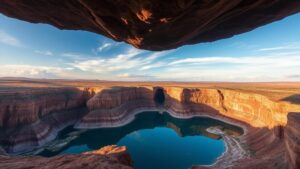Exploring the “Fountain of Sparks,” a geothermal spring in Iceland rumored to emit glowing particles at night.
Exploring the Fountain of Sparks: A Geothermal Wonder in Iceland
Iceland, renowned for its breathtaking natural landscapes and geothermal wonders, is home to the remarkable Fountain of Sparks. This geothermal spring, located near the town of Hveragerði, is not just another hot spring; it has captured the imagination of visitors with its rumored ability to emit glowing particles at night, creating a captivating spectacle.
Geographical Context
Situated approximately 45 kilometers east of Reykjavik, the capital of Iceland, the Fountain of Sparks lies within the popular Golden Circle route. Hveragerði itself is known as the hot spring town owing to its unique volcanic activity, which provides excellent opportunities for exploration and relaxation. The town has a population of about 2,200 residents and serves as a gateway to some of Icelands stunning geothermal sites.
Geothermal Features
The Fountain of Sparks is part of a larger geothermal system in the region that includes geysers, hot springs, and mud pots. heat generated beneath the Earths crust is a result of volcanic activity, and it is this heat that contributes to the unique characteristics of the Fountain of Sparks. Visitors can expect to see bubbling hot springs and steam vents that create a surreal atmosphere, especially when the sun sets.
The Myth of the Glowing Particles
What sets the Fountain of Sparks apart is the local legend that it emits glowing particles at night. While this phenomenon has not been scientifically proven, it draws numerous tourists eager to witness the magical sight. glowing effect is believed to be enhanced by the presence of minerals in the spring and the steams interaction with the night air, creating an ethereal glow reminiscent of fireflies.
Visitor Experience
For those wishing to experience the Fountain of Sparks, a visit is recommended during the late evening hours, ideally during the winter months when nights are long and dark. The surrounding landscape, illuminated by the stars and the potential glow of the spring, offers photographers and nature lovers alike a fantastic opportunity for stunning imagery.
Safety Precautions
While visiting geothermal sites can be magical, it is essential to prioritize safety. Follow these guidelines to ensure a safe experience:
- Stick to marked paths and designated viewing areas.
- Do not attempt to touch the water, as it can reach dangerously high temperatures.
- Carry proper gear, including sturdy footwear and warm clothing, as the terrain can be rugged.
Real-World Applications and Scientific Interest
Beyond its aesthetic allure, the Fountain of Sparks and other geothermal hotspots in Iceland are of great interest to scientists and energy engineers. geothermal energy sector plays a critical role in the country’s renewable energy landscape, with around 85% of homes in Iceland relying on geothermal heating. This clean and sustainable energy source has positioned Iceland as a leader in geothermal energy usage worldwide.
Conclusion: Actionable Takeaways
The Fountain of Sparks not only offers a unique glimpse into Icelands geothermal landscapes but also showcases the blending of natural beauty with cultural lore. Visitors are encouraged to:
- Plan their visit in the evening to enjoy the full experience.
- Bring a camera to capture the stunning landscapes.
- Respect the natural environment and ensure their safety while exploring.
As you embark on your journey to discover the magic of the Fountain of Sparks, remember that you’re not just witnessing a natural wonder; you’re participating in a rich tradition of storytelling and exploration that has shaped Icelands cultural identity.

